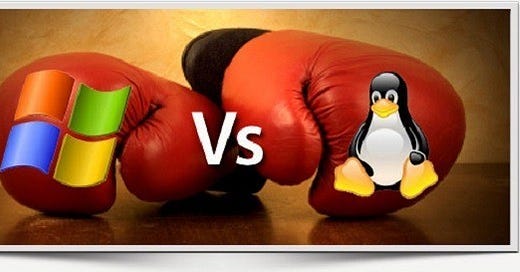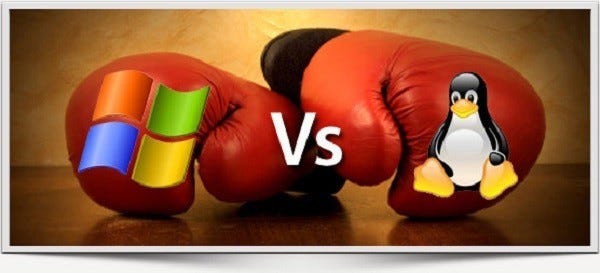Can Microsoft Really Rival Linux?
Click to read the full story: Can Microsoft Really Rival Linux?
Can Microsoft really rival Linux? That’s a strange question in the consumer-level point of view. Wherever have we seen any laptops or desktops in display shelves with some form Linux? It’s rare, except for Chromebooks which are growing in popularity. As per Ars Technica’s stats for desktop operating system market share last 2014, various versions of Windows are used by over 95 percent of desktops worldwide. So in the desktop arena, the answer is yes. In the server arena, Linux is more preferred than Windows, because of better security, fault tolerance, resource management and total cost of ownership. But Microsoft wants to change that by announcing the development of a stripped-down Windows Server called Nano Server which is part of the upcoming Windows Server vNext.
As per W3Techs, web servers that use Linux have 36.72% market share while Windows has 33.10% as of November 2014. Other Operating systems such as FreeBSD and Unix-based servers have a combined share of 30.18%. On mainframes, Linux has a 28% market share while the remaining percentage belongs to Unix. According to Top500, Linux is used in 97% of all supercomputers.
Why the high numbers for Linux? Linux is more stable. Linux servers have been known to run without failure for several years. That’s because Linux handles multitasking and process management better than Windows. That is debatable on the mobile area since many cheap Android (a Linux descendant) devices often freeze. Linux is also more secure since it’s built as a multiuser operating system from the ground up. It is better at sandboxing or containing applications and processes from the root system than Windows does. Linux servers are also minimal targets of hackers and malware, though not exactly a guarantee but it’s something to take advantage of. As for hardware requirements, Linux can be run on most computers. Depending on the distribution, Linux can run very smoothly on ten-year old computers. Lastly, all Linux distributions are free though some versions for the enterprise, like Red Hat, offer technical support for a fee.
The problem with Linux however, is finding talented administrators who can handle the job of company server administration as well as marry Linux and Microsoft technologies. Another difficulty involves the desktop or user level, because Linux has a rather steep learning curve for both new computer users and users weaned on Windows technologies. Applications such as Microsoft Office and Adobe Photoshop remain the de-facto standard for productivity that their open-source equivalents have yet to match. Many companies prefer to receive Microsoft Office documents instead of formats from Open Office or Libre Office. Yet Linux continues to gain traction in the desktop world through Chromebooks, Android desktops and other distros such as Ubuntu, Debian and Mint. Microsoft has also made some compromises by offering its Office apps for Android users but at the same time, trying to regain its lost market share due to the backlash from Windows 8 by suggesting optional enforcement of UEFI to its OEMs.
Microsoft currently has no need to worry in the desktop world so they need to continue improving their chances in the server world. Their 33 percent market there is not bad; but in the spirit of competition, of innovation as well of revenues, they need to do better. Many web companies such as Google and Twitter run server farms running on Linux. Web startups continue to pop up in Silicon Valley and all over the world and Microsoft has to prove that they are better than Linux. They do have a big advantage when it comes to the desktop and other technologies and they can push that advantage to the server level. As for web hosting and web services, Microsoft needs to offer a slimmer form of Windows with better container technologies than their current Server Core which is part of Windows Server 2008 onwards.
That is where the next version of Windows Server comes in, called Windows Server vNext, and part of it is Nano Server. As the name suggests, it’s an installation option with a minimal footprint similar to but smaller than Server Core. Nano Server features better container management, in tandem with Hyper-V technology. It’s also optimized for cloud-based applications. Nano server also promises added container-level security. Nano Server is part of Microsoft’s program of getting along with everything else instead of pushing its own agendas since the appointment of Satya Nadella as CEO. Basically, if you can’t beat them, join them.
When it comes to cloud computing, it’s important for providers to make use of container technology or the ability to run multiple isolated systems; the way Linux CoreOS can run several Linux virtual machines. Nano Server is designed to do the same in tandem with Windows Hyper-V technology. Microsoft’s promise of added security could easily appeal to many businesses and government agencies especially in today’s computing atmosphere saturated with hacking and espionage. Also, aside from the added security, Microsoft also takes a page from CoreOS in terms of ease of installation. Microsoft’s only caveat in this endeavor would be licensing fees which in the Linux world is practically unheard of. But as mentioned, Microsoft can still trump that its desktop level and server level technologies can work well together. Can Microsoft really rival Linux? Nano Server isn’t out yet. Time will tell but they’re certainly giving it a try.
The post Can Microsoft Really Rival Linux? appeared first on Movie TV Tech Geeks News By: Marius Manuella





